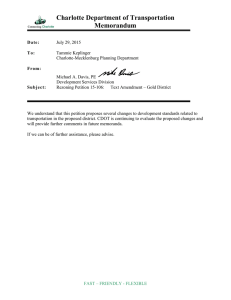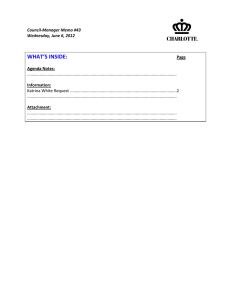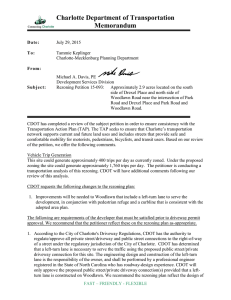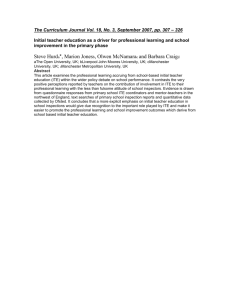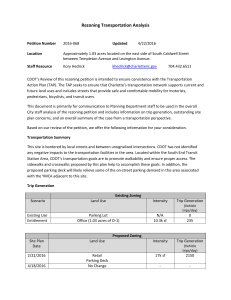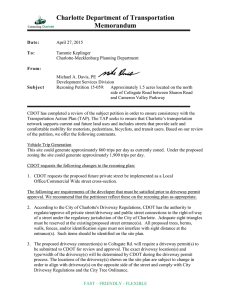Rezoning Transportation Analysis
advertisement
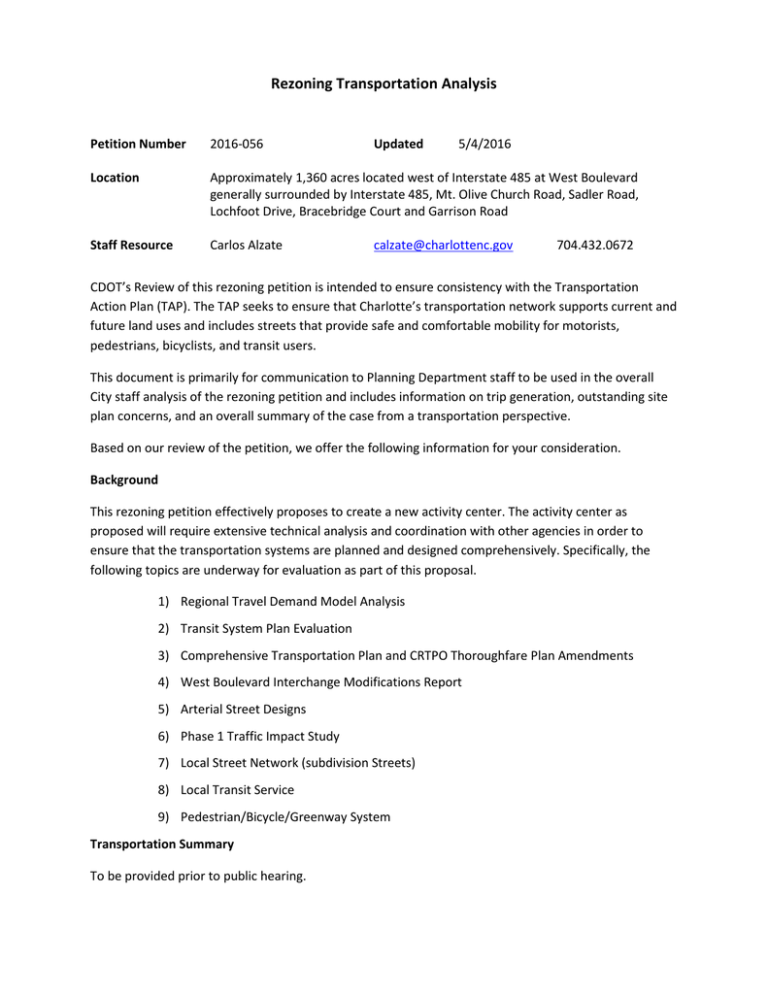
Rezoning Transportation Analysis Petition Number 2016-056 Updated 5/4/2016 Location Approximately 1,360 acres located west of Interstate 485 at West Boulevard generally surrounded by Interstate 485, Mt. Olive Church Road, Sadler Road, Lochfoot Drive, Bracebridge Court and Garrison Road Staff Resource Carlos Alzate calzate@charlottenc.gov 704.432.0672 CDOT’s Review of this rezoning petition is intended to ensure consistency with the Transportation Action Plan (TAP). The TAP seeks to ensure that Charlotte’s transportation network supports current and future land uses and includes streets that provide safe and comfortable mobility for motorists, pedestrians, bicyclists, and transit users. This document is primarily for communication to Planning Department staff to be used in the overall City staff analysis of the rezoning petition and includes information on trip generation, outstanding site plan concerns, and an overall summary of the case from a transportation perspective. Based on our review of the petition, we offer the following information for your consideration. Background This rezoning petition effectively proposes to create a new activity center. The activity center as proposed will require extensive technical analysis and coordination with other agencies in order to ensure that the transportation systems are planned and designed comprehensively. Specifically, the following topics are underway for evaluation as part of this proposal. 1) Regional Travel Demand Model Analysis 2) Transit System Plan Evaluation 3) Comprehensive Transportation Plan and CRTPO Thoroughfare Plan Amendments 4) West Boulevard Interchange Modifications Report 5) Arterial Street Designs 6) Phase 1 Traffic Impact Study 7) Local Street Network (subdivision Streets) 8) Local Transit Service 9) Pedestrian/Bicycle/Greenway System Transportation Summary To be provided prior to public hearing. Trip Generation The proposed development could generate 120,000 trips per day as proposed. Based on review of national and local information, we estimate that approximately 45,000 of these trips will be captured internally within the Center and 75,000 of these trips will enter or exit the center. In order to ensure that these trips can be served adequately, the proposed transportation network must include a dense internal local street network supported by a system of well-designed arterial streets that have good connectivity to I-485. Site Plan District Employment Town Center Gateway Transitional Residential Uses ITE Code Intensity Trips Per Day Apartment Hotel Office Retail Apartment Hotel Office Retail Hotel Office Retail Apartments Office Retail Single Family Apartment Retirement Community (CCRC) Retail [ITE 220/Eq.] [ITE 310/Rates] [ITE 710/Eq.] [ITE 820/Eq.] [ITE 220/Eq.] [ITE 310/Rates] [ITE 710/Eq.] [ITE 820/Eq.] [ITE 310/Rates] [ITE 710/Eq.] [ITE 820/Eq.] [ITE 220/Eq.] [ITE 710/Eq.] [ITE 820/Eq.] [ITE 210/Eq.] [ITE 220/Eq.] 500 dwellings 250 rooms 4.5 million sf 50k sf 1700 dwellings 500 rooms 2 million sf 300k sf 250 Rooms 500k sf 50k sf 300 dwellings 1 million sf 25k sf 1700 dwellings 300 dwellings 3,154 2,043 23,694 4,328 10,426 4,085 12,793 13,870 2,043 4,461 4,328 1,942 7,554 2,758 14,233 1,942 [ITE 255/Rates] 200 units 480 [ITE 820/Eq.] 75k sf Total 5,633 119,767 Existing Zoning Scenario Land Use Intensity Trip Generation (Vehicle trips/day) Existing Use Entitlement Various Low-Density Uses Need Information from Planning - - Curbline Setbacks in the proposed zoning district will be measured from proposed future curblines. The curblines for local streets will be based on the standard local streets in the Charlotte Land Development Standards Manual or as otherwise prescribed in the conditional zoning plan. The future curblines for the arterial streets will be determined through the design process after the zoning decision. Resolved Issues N/A Outstanding Issues Due to the large size of this rezoning petition and complexity of the activities described in the background above, additional outstanding issues may be identified as the technical review continues. 1. CDOT does not support the “Transportation Methodology” as described on Sheet RZ-5A, which defers all analysis of future transportation commitments beyond phase 1 to further undefined transportation studies. CDOT is aware that concurrent discussions are underway between petitioner and the City to establish an MOU that deals with a variety of aspects of this petition and that this MOU could identify an alternate approach to transportation requirements. Regardless of the particular approach taken through the MOU, the conditional zoning plan will need to include greater specificity on either the specific improvements that are expected, or the technical approach to determining the required mitigations over time. 2. The existing West Blvd / I-485 interchange with the improvements described under phase 1 are inadequate to support the remaining entitlements beyond phase 1. CDOT’s support for the entitlements beyond phase 1 is contingent on a reconstruction of the I-485 / West Boulevard interchange to allow two arterial crossings of I-485, each with access to freeway ramps. The petitioner has begun discussions with NCDOT to propose an interchange modification to accomplish this; however, the approval decision from NCDOT and FHWA is expected to occur after the requested City Council action to approve the rezoning petition. 3. The traffic impact study for phase 1 includes specific improvement recommendations for transportation improvements. CDOT has completed a review of this study and has the following preliminary recommendations for laneage. These recommendations are in addition to those already provided by NCDOT’s Congestion Management Unit in their March 29 report. I-485 Outer Loop at West Boulevard intersection (proposed traffic signal): a. I-485 Outer Loop off-ramp lane configuration: 1 left turn only lane, 1 shared left-thru lane, 2 right-turn only lanes. b. EB West Blvd lane configuration: 1 thru lane, 1 shared thru-right lane, with 2 EB receiving lanes on the east side of the intersection – a 3rd EB lane will form east of the taper that forms the WB left turn lanes at this intersection. This lane will drop as one of the left turn only lanes at the I-485 Inner Loop intersection. c. WB West Blvd lane configuration: 2 left turn only lanes, 2 thru lanes (2nd thru lane forms on west side of bridge over I-485) West Boulevard Bridge over I-485: Total of 4 lanes, 1 WB lane and 3 EB lanes (left-most EB lane will drop as one of the two left turn only lanes at the I-485 Inner Loop and West Blvd intersection). I-485 Inner Loop at West Boulevard intersection (proposed traffic signal): d. I-485 Inner Loop off-ramp lane configuration: 1 left turn only lane, 1 shared thru-right lane e. EB West Blvd lane configuration: 2 left turn only lanes (1st lane is a drop of the left-most thru lane, the 2nd lane forms immediately east of the West Blvd bridge over I-485) f. WB West Blvd lane configuration: 1 thru lane, 1 right turn only lane Wallace Neal Road at West Boulevard (proposed traffic signal): g. EB West Blvd lane configuration: 1 left turn only lane, 2 thru lanes (1 thru lane will drop before the bridge on West Blvd to the east of this intersection) h. Lane configurations of other approaches are the same as NCDOT recommendations. West Boulevard/Byrum Drive & Steele Creek Road Intersection (existing traffic signal): i. Same comments as NCDOT 4. West Boulevard is expected to be relocated on the east side of I-485 in order to support future airport expansion. CDOT requests a note be added to the plan that identifies that a) construction coordination will be necessary with the planned relocation and b) the proposed mitigations at Steele Creek West Boulevard and Byrum will be transferred to the proposed new intersection at the western terminus of the West Blvd realignment project to be funded by the petitioner in the event that the relocation occurs prior to the development mitigations. 5. The proposed Boulevard A (Linear Park) cross-section does not match USDG recommended crosssections. Boulevard A should have a 17-foot wide median. 6. The “Green Street” cross-section shows a 10-foot wide multi-use path on only 1 side of the street. The multi-use path width is not adequate for two way bike traffic and pedestrians and should be at least 12’ wide. 7. CDOT expects to have additional comments regarding supplemental language for ensuring an adequate local street network beyond the standard requirements of the Subdivision Ordinance. 8. Transportation network information in Residential District is less defined than other districts in this submittal. What is proposed for new and existing facilities 9. CDOT is concerned about the optional provisions that erode the potential of the development to succeed as a multi-modal place. In particular, CDOT is concerned about allowing parking between the streets and the buildings, not recessing doors onto sidewalks. 10. CDOT understands that the Planning Department is offering specific recommendations that will help ensure an adequate street network will be created beyond what might be the minimum required by the Subdivision Ordinance. CDOT supports this any changes made to the plan that will help achieve the preferred block spacing for Activity Centers. 11. We recommend elimination of the language that describes which local street sections will be used. This should be addressed through application of the Subdivision requirements. 12. CDOT supports the language in the notes establishing the minimum number of crossings of the Beaver Dam Creek. CDOT recommends additional language be provided to describe when these bridges will be created with respect to development activity. Also, the notes should commit that the bridges will provide adequate clearance to accommodate greenway underpasses. 13. The greenway system envisioned for this site will become an integral part of the walking and bicycling network once constructed. We request a greenway system plan be included that depicts the intended limits of the greenways. 14. We recommend eliminating the Notes IV a.1-a.3. This language does not seem useful in a conditional zoning document. We recommend consideration be given to replacing all of note IV with a statement that simply acknowledges the existence of an MOU which describes the topics listed. 15. The language used for substantial completion must be changed to eliminate the use of the phrase ”CDOT will instruct.” CDOT is not in a position to direct the work of other agencies. CDOT supports the idea of deeming a project substantially complete, subject to evaluation of safety and operational need for the improvements to be completed concurrent with a building opening. We recommend a statement indicating “CDOT may deem a project substantially complete for the purposes of...” as a replacement. 16. CDOT supports the idea of alternative street designs that offer environmental benefits. However, any specific designs must be evaluated through design review. The references to BMP’s in the public street right-of-way must clarify that this is subject to review and approval by CDOT or NCDOT as applicable. 17. Since different development ordinances and zoning districts create different requirements for improvements to non-local streets, we recommend a note that explicitly requires that as development occurs, the fronting non-local streets must be built, or if mutually agreeable, funding provided to the City for non-local street construction. This would include travel lanes, bike facilities, gurb-and-gutter, planting strip, and sidewalks. 18. All right-of-way for the arterial streets should be dedicated by the petitioner. Advisory Information The following are requirements of the developer that must be satisfied prior to driveway permit approval. We recommend that the petitioner reflect these on the rezoning plan as-appropriate. 1. According to the City of Charlotte's Driveway Regulations, CDOT has the authority to regulate/approve all private street/driveway and public street connections to the right-of-way of a street under the regulatory jurisdiction of the City of Charlotte. 2. Adequate sight triangles must be reserved at the existing/proposed street entrance(s). Two 35’ x 35’ sight triangles are required for the entrance(s) to meet requirements. All proposed trees, berms, walls, fences, and/or identification signs must not interfere with sight distance at the entrance(s). Such items should be identified on the site plan. 3. The proposed driveway connections will require driveway permits to be submitted to CDOT and the North Carolina Department of Transportation for review and approval. The exact driveway locations and type/width of the driveways will be determined by CDOT during the driveway permit process. The locations of the driveways shown on the site plan are subject to change in order to align with driveways on the opposite side of the street and comply with City Driveway Regulations and the City Tree Ordinance. 4. All proposed commercial driveway connections to a future public street will require a driveway permit to be submitted to CDOT for review and approval. 5. Any fence or wall constructed along or adjacent to any sidewalk or street right-of-way requires a certificate issued by CDOT. 6. A Right-of-Way Encroachment Agreement is required for the installation of any non-standard item(s) (irrigation systems, decorative concrete pavement, brick pavers, etc.) within a proposed/existing City maintained street right-of-way by a private individual, group, business, or homeowner's/business association. An encroachment agreement must be approved by CDOT prior to the construction/installation of the non-standard item(s). Contact CDOT for additional information concerning cost, submittal, and liability insurance coverage requirements.
